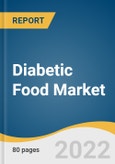The global diabetic food market size is expected to reach USD 20.6 billion by 2030. The market is expected to expand at a CAGR of 5.9% from 2022 to 2030. Growing awareness of diabetes coupled with preventive measures taken by consumers is anticipated to spur market growth. Increasing use of artificial sweeteners including acesulfame potassium, aspartame, and neo-tame as a substitute for sugar is expected to positively impact market growth.
Rising health concerns and an uptrend in the occurrence of diabetes among youngsters, and health issues such as obesity, diabetes, and digestive disorders have prompted consumers to opt for diabetic food solutions. Moreover, increasing cases of juvenile diabetes among children and youth owing to lack of physical activity is expected to fuel the demand. Moreover, some health-conscious consumers are also attracted towards diabetic food in order to maintain their general health and wellness.
Product launches in segments such as confectionery, and bakery by key players in the market are likely to supplement the overall market growth. For instance, in November 2021 Teatis, the nutrition brand catering to diabetics, launched their new subscription box service including Teatis Meal Box, featuring a selection of healthy snacks and meal replacements that are suitable for diabetics. The meal box includes plant-based smoothies, low-carb cereal, keto bar, and dark chocolate keto-friendly cereal.
The supermarkets and hypermarkets distribution channel segment held the largest segment in 2021 and is expected to maintain dominance over the forecast period. The rise in demand for diabetic food by the consumers has made retailers hold greater shelf spaces for diabetic food, especially in no sugar or zero sugar categories. Further, the availability of a wide range of brands also encourages consumers to shop through these channels. The market is consolidated in nature with the presence of a large number of international players and few regional players.
Rising health concerns and an uptrend in the occurrence of diabetes among youngsters, and health issues such as obesity, diabetes, and digestive disorders have prompted consumers to opt for diabetic food solutions. Moreover, increasing cases of juvenile diabetes among children and youth owing to lack of physical activity is expected to fuel the demand. Moreover, some health-conscious consumers are also attracted towards diabetic food in order to maintain their general health and wellness.
Product launches in segments such as confectionery, and bakery by key players in the market are likely to supplement the overall market growth. For instance, in November 2021 Teatis, the nutrition brand catering to diabetics, launched their new subscription box service including Teatis Meal Box, featuring a selection of healthy snacks and meal replacements that are suitable for diabetics. The meal box includes plant-based smoothies, low-carb cereal, keto bar, and dark chocolate keto-friendly cereal.
The supermarkets and hypermarkets distribution channel segment held the largest segment in 2021 and is expected to maintain dominance over the forecast period. The rise in demand for diabetic food by the consumers has made retailers hold greater shelf spaces for diabetic food, especially in no sugar or zero sugar categories. Further, the availability of a wide range of brands also encourages consumers to shop through these channels. The market is consolidated in nature with the presence of a large number of international players and few regional players.
Diabetic Food Market Report Highlights
- North America is expected to contribute a majority of the share to become the largest division in the global revenue in 2021. Sugar-free, low carb food preferences among the diabetic consumers are increasing the demand for diabetic food in the region.
- The snacks segment is projected to register the fastest growth during the forecast period from 2022 to 2030 owing to demand for small and quick food products.
- The online distribution channel segment is expected to register the fastest growth during forecast period. The recent outbreak of COVID-19 has increased the penetration of online retailers in diabetic food segment.
Table of Contents
Chapter 1 Methodology and Scope
Chapter 2 Executive Summary
Chapter 3 Diabetic Food Market Variables, Trends & Scope
Chapter 4 Consumer Behavior Analysis
Chapter 5 Diabetic Food Market: Product Estimates & Trend Analysis
Chapter 6 Diabetic Food Market: Distribution Channel Estimates & Trend Analysis
Chapter 7 Diabetic Food Market: Regional Estimates & Trend Analysis
Chapter 8 Competitive Analysis
Chapter 9 Company Profiles
Companies Mentioned
- Nestlé
- Unilever
- the Kellogg Company
- Conagra Brands, Inc.
- Fifty 50 Foods, Inc.
- Mars Inc.
- Tyson Foods
- Sushma Gram Udyog
- the Hershey Company
- Hain Celestial Group
Methodology

LOADING...
Table Information
| Report Attribute | Details |
|---|---|
| No. of Pages | 80 |
| Published | April 2022 |
| Forecast Period | 2022 - 2030 |
| Estimated Market Value ( USD | $ 13 Billion |
| Forecasted Market Value ( USD | $ 20.6 Billion |
| Compound Annual Growth Rate | 5.9% |
| Regions Covered | Global |
| No. of Companies Mentioned | 10 |









